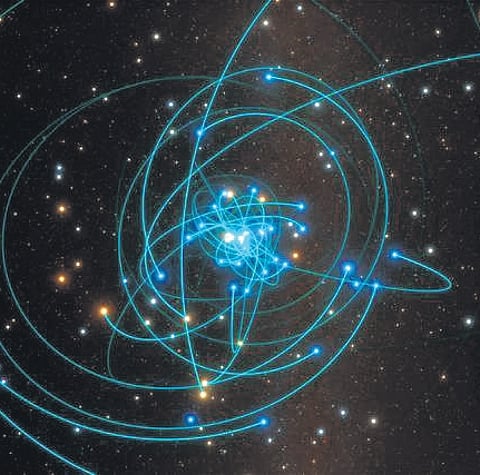

Despite their ancient age, some stars orbiting the Milky Way’s central supermassive black hole appear deceptively youthful. But unlike humans, who might appear rejuvenated from a fresh round of collagen injections, these stars look young for a much darker reason. They ate their neighbours. This is just one of the more peculiar findings from new Northwestern University research. Using a new model, astrophysicists traced the violent journeys of 1,000 simulated stars orbiting our galaxy’s central supermassive black hole, Sagittarius A* (Sgr A*).
So densely packed with stars, the region commonly experiences brutal stellar collisions. By simulating the effects of these intense collisions, the new work finds that collision survivors can lose mass to become stripped down, low-mass stars or can merge with other stars to become massive and rejuvenated in appearance.
“The region around the central black hole is dense with stars moving at extremely high speeds,” says Northwestern’s Sanaea C Rose, who led the research. “It’s a bit like running through an incredibly crowded subway station in New York City during rush hour. If you aren’t colliding into other people, then you are passing very closely by them. For stars, these near collisions still cause them to interact gravitationally. We wanted to explore what these collisions and interactions mean for the stellar population and characterise their outcomes,” she says.
Destined to collide
The centre of our Milky Way is a strange and wild place. The gravitational pull of Sgr A* accelerates stars to whip around their orbits at terrifying speeds. And the sheer number of stars packed into the galaxy’s centre is upwards of a million. The densely packed cluster, plus the lightningfast speeds equal a high-speed demolition derby. In the innermost region — within 0.1 parsecs of the black hole — few stars escape unscathed.
“The closest star to our Sun is about four light-years away,” Sanaea explains, adding, “Within that same distance near the supermassive black hole, there are more than a million stars. It’s an incredibly crowded neighbourhood. On top of that, the supermassive black hole has a really strong gravitational pull. As they orbit the black hole, stars can move at thousands of kilometres per second.”
Within this tight, hectic neighbourhood, stars can collide with other stars. And the closer stars live to the supermassive black hole, the likelihood of collision increases. Curious of the outcomes of these collisions, Sanaea and her collaborators developed a simulation to trace the fates of stellar populations in the galactic centre. The simulation takes several factors into account: density of the stellar cluster, mass of the stars, orbit speed, gravity and distances from the Sgr A*.
From ‘violent high fives’ to total mergers
In her research, Sanaea pinpointed one factor that is most likely to determine a star’s fate: its distance from the supermassive black hole. Within 0.01 parsecs from the black hole, stars — moving at speeds reaching thousands of kilometres per second — constantly bump into one another. It’s rarely a head-on collision and more like a “violent high five”, as Sanaea describes it. T
he impacts are not strong enough to smash the stars completely. Instead, they shed their outer layers and continue speeding along the collision course. “They whack into each other and keep going,” she says. “They just graze each other as though they are exchanging a very violent high five. This causes the stars to eject some material and lose their outer layers. Depending on how fast they are moving and how much they overlap when they collide, they might lose quite a bit of their outer layers. These destructive collisions result in a population of strange, stripped down, low-mass stars.”
Outside of 0.01 parsecs, stars move at a more relaxed pace — hundreds of kilometres per second as opposed to thousands. Because of the slower speeds, these stars collide with one another but then don’t have enough energy to escape. Instead, they merge to become more massive. In some cases, they might even merge multiple times to become 10 times more massive than our Sun.
“A few stars win the collision lottery,” Sanaea says, adding, “Through collisions and mergers, these stars collect more hydrogen. Although they were formed from an older population, they masquerade as rejuvenated, young-looking stars. They are like zombie stars; they eat their neighbours.” But the youthful appearance comes at the cost of a shorter life expectancy. “They die very quickly,” Sanaea says. “Massive stars are sort of like giant, gas-guzzling cars. They start with a lot of hydrogen, but they burn through it very, very fast,” she adds.
Environment ‘unlike any other’
Although Sanaea finds simple joy in studying the bizarre, extreme region near our galactic centre, her work also can reveal information about the history of the Milky Way. And because the central cluster is extremely difficult to observe, her team’s simulations can illuminate otherwise hidden processes. “It’s an environment unlike any other,” she explains.
“Stars, which are under the influence of a supermassive black hole in a very crowded region, are unlike anything we will ever see in our own solar neighbourhood. But if we can learn about these stellar populations, then we might be able to learn something new about how the galactic centre was assembled. At the very least, it certainly provides a point of contrast for the neighbourhood where we live.”
Our nearest black hole
Sagittarius A* (pronounced ‘Sagittarius A star’) is over 25,000 light years from Earth – our nearest supermassive black hole
Often abbreviated to Sgr A*, it sits in the Sagittarius constellation at the very heart of the Milky Way
Sgr A* has an estimated mass millions of times that of our Sun
Sgr A* woke some 200 years ago to devour cosmic debris, according to new findings from NASA’s Imaging X-ray Polarimetry Explorer
Sources: NASA, Northwestern University